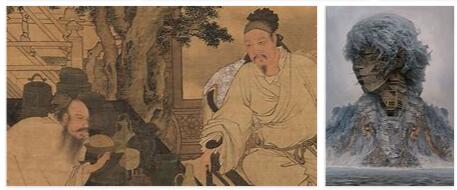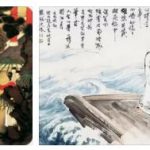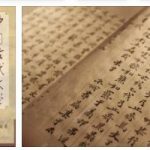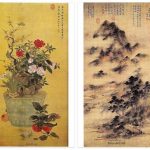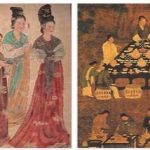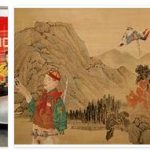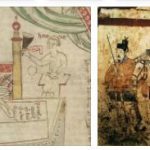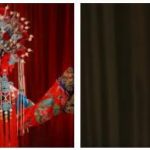Chinese art The earliest evidence of Chinese art are the ceramics found in graves and settlements of the late Neolithic (around 5000–2000 BC) of the cultures named after the first sites of Yangshao (Henan), Majiayao (Gansu) and Longshan (Shandong).
Shang dynasty
(around 16th century – 1050 BC)
An idea of the art of the Shang dynasty is given by v. a. the foundations of the second Shanghai capital Ao (today Zhengzhou) excavated in the vicinity of today’s Zhengzhou with remains of bronze foundries, ceramic workshops and a city wall made of rammed earth as well as the oracle bone finds and the cruciform ones, rich in sacral bronzes, bronze weapons, ceramics, jade and nephrite shaft tombs of the last Shang rulers near Anyang. The decoration of the sacral bronzes includes apotropaic masks (Taotie) as well as zoomorphic and geometric motifs. The sparse relief decoration is affixed in ribbons on the pieces from the early Shang period; it was not until the late Shang and early Zhou periods that it covered the entire vessel and was more vividly worked out. In the late Shang period, local high cultures developed, among which the culture named after the place where it was found Sanxingdui (Sichuan) is particularly noteworthy.
Western and Eastern Zhou Dynasty
(around 1050–771 BC and 771–249 BC)
From the middle of the Western Zhou dynasty, the motifs of the bronze vessels were increasingly abstracted and dissolved into intertwined ribbon ornaments. The advance of nomadic fringe peoples from the Ordos area led to the relocation of the Zhou capital east to the city of Luoyi (today Luoyang; Eastern Zhou Dynasty). The cultural exchange that began from the beginning of the 8th to the beginning of the 5th century through contact with the steppe peoples is manifested in bronze art in an animal style decor resembling the southern Siberian grave finds and increasingly realistic representations (including scenes of archers, dances, hunting), but also in the belt buckles and vestments adopted from the nomadic equestrian costume. The adoption of the technique of gold and silver inlaid as well as turquoise and malachite inlay led to the first high point of Chinese gold and silversmithing.
The Warring States Period
(481–221 BC)
The collapse of power of the Zhou and the increasing independence of the feudal princes led to a luxury development in the princely tombs, which were v. a. expresses himself in carefully and detailed worked items of personal needs. In the province of Hubei, in the region of the former southern state of Chu, bronze mirrors, chimes, horses buried with head masks (to ward off demons), lacquered wooden figures serving as grave guards, jade carvings, painted and written silk scarves (near Changsha) and clay vessels with feldspar glaze were excavated. The color-lacquered wood carvings and the power supplies with lacquer paintings are stylistically dependent on the figurative motifs and abstract ornamental decorations of bronze art.
Qin time
(221–206 BC)
The monumental grave sculpture, which has been excavated since 1974 in the area around the burial mound of Qin Shi Huangdi (Ch’in Shih Huang-ti) near Lintong (Shaanxi), who called himself the “First Divine Exalted”, offers an insight into the long underestimated art of the Qin period. Previously only the historical achievements of this first Chinese emperor were known, such as the centralization of administration and the erection of the “Great Wall” (Great Wall of China). A visible expression of his claim to rule and his Daoist-influenced belief in the hereafter, which is tied to this world, is his grave complex, which was built within a decade. Around the burial mound, conceived as a cosmic universe and palace city, an army of more than 7,000 individual figures of life-size armed infantrymen, cavalrymen, war horses, squares and chariots was brought into position in underground corridors. The sculptures, which were fired from hard gray clay at relatively high temperatures, are likely to have been made in large, organized workshops. The individual pieces pressed from models were put together before firing and finally painted in true colors with cold paint. Hands and heads modeled differently over a raw form were burned separately.
Western and Eastern Cell Dynasty
(206 BC – 9 AD and 25–220 AD)
The expansion of the empire of the mobile dynasty to Southeast Asia (mainland), East Turkestan and North Korea resulted in a lively exchange of goods and cultures. The supremacy of China, a country located in Asia according to hyperrestaurant.com, and the influence of its civilization on the neighboring areas are testimony to the archaeological finds from the graves in Noin Ula (Mongolia) and Lolang (North Korea). The most important grave finds of the earlier Western Hanzeit include the rock graves in Mancheng (Hebei) with two funeral robes made of jade, which each consist of more than 2,000 jade plates attached to each other with gold wire and were supposed to protect the corpse from decay. The graves and their finds (lacquerware, ceramics, textiles, etc.), discovered in Mawangdui near Changsha in the 1970s, are also of outstanding importance. The grave of the Margravine von Dai brought z. B. a T-shaped, Dead banner (Feiyi, Fei-i), which suggests that the portrait-format picture form of the hanging scroll, which has been gaining popularity in profane painting since the time of the Five Dynasties (907-960), originated in the banner of the death of the Hanse and not, as previously assumed, in the temple banners that later came to China with Buddhism. Typical examples of the lacquer art of the Hanzeit are the three nested coffins of the Margravine von Dai. Decorative borders with cloud spiral patterns and depictions of winged horses, cranes, unicorns and other fantasy creatures are characteristic. Innovations in the grave are often fire-gilded bronze oil lamps in the form of a round plastic figure holding the flat bowl, as well as incense burners decorated with inlays and incrustations. The belt buckles, robe clips and bronze mirrors are also characterized by an increasingly narrative-realistic style. The silk robes unearthed in Mawangdui give an idea of the highly developed Chinese textile art. In the 1st century AD, brick chamber tombs vaulted with real barrel vaults or false domes made of protruding brick layers were widespread. For the wall cladding, lintels and gable areas, stone reliefs or relief bricks, openwork or decorated with impressed patterns, and later also with wall paintings were used. The representations show cosmological-symbolic or historical-instructive topics. A layer of mortar served as a painting surface for the figures lined up in parallel, often depicted with very lively gestures, which were outlined with black ink and colored in. They give an idea of the high level of painting in the palaces of the Hanse period, otherwise known only from literary sources. The clay figures of warriors, horses and musicians, which are very numerous in the grave, cold-painted or provided with lead-silicate glazes, together with clay models of household items, stables, residential houses and multi-storey watchtowers in post construction convey an image of the culture and architecture of the Hanzeit.
